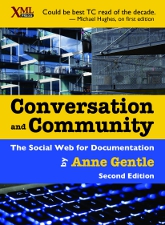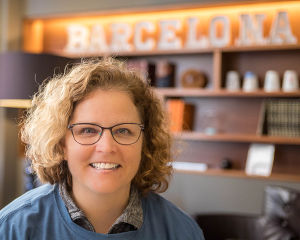
Out of print — March 2020
Anne Gentle’s book, Conversation and Community: The Social Web for Documentation, is now available for free online in ePub, Kindle, and PDF format under the Creative Commons Attribution-Noncommercial 3.0 Unported License. For more about this license, see More about this license below.
Read Anne Gentle’s blog at JustWriteClick.com for more about this book and Anne’s other book, Docs Like Code.
To get your free copy of the ebook edition, go to the XML Press eBook store
Anne Gentle’s Conversation and Community, has become the go-to reference for social media and technical communication. Her clear-eyed survey of the social media landscape has been adopted by many universities and is widely used by technical communicators.
The second edition contains new chapters on building a content strategy, analyzing web techniques, and developing an open source strategy. Along with a greatly expanded bibliography and updates throughout, there are more interviews and more case studies, making this ground-breaking book even more useful.
Inside the Book
- Towards the Future of Documentation
- How people communicate about technical topics today
- The changing roles of writers
- Defining conversation
- Agile development
- Why move content to the social web?
- Social media, social networking, and now the social web
- Defining a Writer’s Role with the Social Web
- Challenges and opportunities
- Building a strategy
- The documentation environment
- Community and Documentation
- What is a community?
- Motivations for writers and online communities
- Real-world events
- Book sprints
- Commenting and Connecting with Users
- Monitoring conversations
- Starting and maintaining a blog
- Customer blog infrastructure
- Integrating user content into user assistance
- Moderating or participating in online forums
- Instant messaging and responses
- Writing reviews
- Integrating social tagging
- Sharing photos and videos for explanation or assistance
- Wikis as Documentation Systems
- Wikis for projects
- Starting or reinvigorating a wiki
- Inheriting a large wiki
- Working in a wiki
- Wiki round tripping
- Single-sourcing and repurposing
- Understanding wiki patterns and wiki structures
- Alternatives when a wiki is not the right match
- Talking with writers of wikis
- Wiki examples
- Wiki wrap up
- Finding Your Voice
- Style guidelines
- Publishing strategies
- Idea generation
- Living and working with conversation and community
- Content Strategy for Community Documentation — NEW Chapter
- Listen and monitor first
- Find the business goals
- Community and content audits
- Case Study: Community Content Strategy at Autodesk
- Analyzing and Measuring Web Techniques — NEW Chapter
- Managing community methods
- Measuring effectiveness
- Fitting into the community
- Encouraging grassroots efforts
- Measuring documentation as conversation
- Open Source Documentation — NEW Chapter
- Open source, how does it work?
- Open documentation community strategies
- Open source starting points
- Licensing considerations
- Not about tools
- Community content strategist
- Appendix A: Concepts and Tools of the Social Web
- New media content categories
- Social web techniques
- Learning about social media
- Appendix B: Easter Seals Internet Public Discourse Policy
- Appendix C: A Case Study from Smart Content in the Enterprise — NEW Case Study
- Managing Content for Continuous Learning at Autodesk: When DITA Flows into a Social Web Platform
- Glossary
- Bibliography — Expanded
- Index
More about the license
Anne’s work history includes experience with open source materials, and in that work she developed an appreciation for attribution and open materials. As a result, this book is licensed under the Creative Commons Attribution-Noncommercial 3.0 Unported License, which is available at http://creativecommons.org/licenses/by-nc/3.0/. While not technically an open source license as defined by the Open Source Initiative (OSI) (https://opensource.org/osd), the intention for choosing a Creative Commons license is to share and share alike.
In plain language, that license means that anyone can copy or adapt, and even distribute text from the book as long as the redistribution gives appropriate credit and does not charge for any adaptations created. This license choice means that people can reuse it in workshops, in classrooms, and even pull out parts of it for reuse in other works. You can even take a BY-NC original work and adapt it and release under a new license, BY-NC-ND (Non-Noncommercial, No Derivatives) or BY-NC-SA (Non-Noncommercial, Share Alike).
The book’s text licensing, version 3.0, was the most recent version at the time of publishing the first edition in 2009, as well as for the second edition in 2012. Has anything changed since then? Yes. The Creative Commons site encourages the use of the latest version, 4.0, because that version is meant to be better suited for international use, and because it can be used in more contexts than just books but also for shared data, which can be quite complex. Shared components of databases you need to consider include the structure, data entry and data output, database field names, and the data itself. As more people use these licenses, the Creative Commons organization recognizes the need to identify which components to cover with the license.
Content licensing is a fascinating area to study and find practical applications. The text can be licensed one way while icons yet another way, images with separate licenses also, and code examples or code snippets in a different license with different rules. In the case of Anne’s book, the photos on the covers of both editions were licensed in such a way that meant reuse was possible. With attribution, the original photographers get the credit for the photo. For example, the Danish typewriter photo on the cover of the first edition is licensed with Attribution 2.0 Generic (CC BY 2.0), https://creativecommons.org/licenses/by/2.0/. As it turned out, the photographer, Jude Theriot, lived in Houston, Texas and could come to Anne’s book release party in Austin. He brought a signed, matted print of the photo as a lovely representation of how sharing content can bring people together in the most unlikely ways.
With this book now released for free with the Creative Commons license, take a look at what you might want to remix, adapt, reuse, and share.
Praise for the First Edition
“Could be best TC read of the decade”
— Michael Hughes, on twitter, @michaelhughesua“I was an early adopter of wikis, but had reached a saturation point after Linkedin and before Facebook. As a result, I was vague on what a lot of these social things are, so Chapter 2 has been useful.”
— David Cramer
“I have felt for a while that this is where I wanted to go as a technical writer, but I wasn’t sure where to start or if it was even possible. Your book is giving me the confirmation that I’m on the right track and all the amazing links in it are helping me develop the knowledge I need to get there. You have no idea how excited I am:)”
— Nathalie Laroche
“…the book has value to web workers of all stripes. The book is practical, up to date and isn’t just a “me too” social media tome.”
— Will Kelly, WebWorkerDaily.com
“The consistent, confident, professional tone kept me riveted…”
“I highly recommend this book to both technical communicators and those involved in social media and community. My copy is going straight to my boss’ desk.”
— Jeff Osier-Mixon, jefro.wordpress.com
“If you think community participation in your documentation is coming soon, read this book immediately. If you think that it’s not coming, you’re wrong, and you especially need to read this book.”
— Sarah O’Keefe, Full review at scriptorium.com
“The book is brim full of useful information and, even better, great ideas”
— Sarah Maddox, Full review
About Anne Gentle

Anne Gentle works as a developer experience manager at Cisco DevNet, the Cisco developer relations program. Cisco DevNet provides developer learning environments and content for trying out Cisco technology for network automation, collaboration, cloud, security, IoT, and many other technology integrations. She is a recognized author whose books promote collaboration among developers, writers, and other stakeholders within open source and enterprise communities. Anne teaches others about API and technical documentation using developer techniques through talks and workshops. At Cisco, she leads the team that provides consistent and standard developer tools for API design, developer documentation, and developer support. She wrote the book, Docs Like Code, to share tested tools and techniques with all who want to provide helpful, accurate technical information to the world. As a supporter of women in technology, Anne coordinated efforts to connect OpenStack to the GNOME Outreach Program for Women, now named Outreachy. She pushes the technical communication field forward towards future opportunities to educate and collaborate from her hometown of Austin, Texas.
